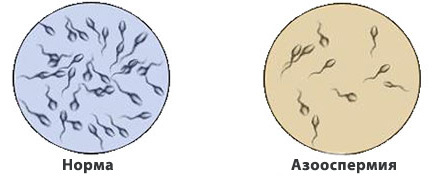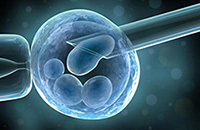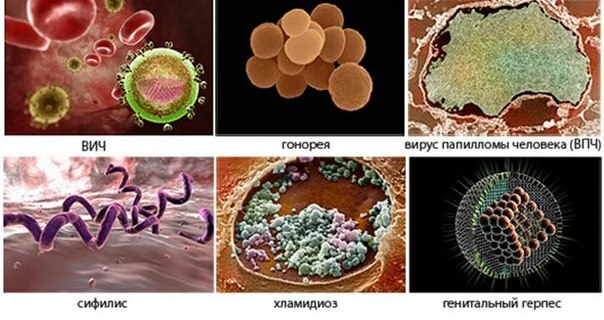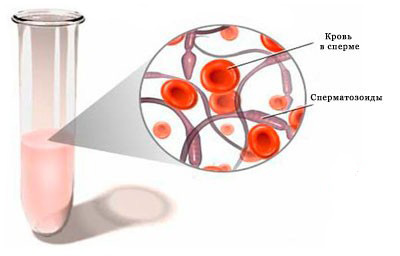Is azoospermia treated in men?
Azoospermia is a serious pathological condition characterized by the total absence of male germ cells in seminal fluid, as a result of which a man can not conceive a child.

Fig.1 - Azoospermia.
Contents
- 1 Forms of azoospermia
- 1.1 Obstructive form
- 1.2 Secretory form
- 2 Symptoms
- 3 Diagnosis
- 4 Treatment
- 5 Forecast for pregnancy
- 6 ECO with azoospermia
Forms of azoospermia
Azoospermia is secretory and obstructive. Each type of pathology has its own characteristics.
Obstructive form
When a man is healthy, the male germ cells through the vas deferens can enter the urethral canal without obstruction. With azoospermia, these ducts are clogged, and spermatozoa do not enter the ejaculate.
Pathology occurs in 35-40% of men. They suffer equally both acquired and congenital form of obstructive azoospermia. The following negative factors may serve as the cause of this condition:
- traumatic injuries of the vulva;
- congenital and acquired abnormalities of organs of the reproductive system;
- infectious and inflammatory diseases of male genital organs.
The inherited predisposition and genetic changes transmitted from the parents lead to a congenital pathology.
With a congenital form of azoospermia, the man has no channels through which the semen is removed from the prostate gland into the urethral canal. Another common cause of obstructive azoospermia is varicocele. In this case, the blood vessels expand, which compress the vas deferens.
Secretory form of
This type of azoospermia occurs much more often than the obstructive form. The disease is a consequence of a violation of the process of spermatogenesis: the produced seminal fluid does not contain male sex cells. To distinguish the secretory form from obstructive it is possible on the basis of data spermogrammy. If single and slow-moving spermatozoa were found during the study of the ejaculate, then it is a secretory form of pathology.
Secretory azoospermia can be both congenital and acquired. Such factors can provoke this condition:
- decrease in testosterone level in the body of a man;
- alcohol consumption and smoking;
- administration of certain groups of drugs( antibacterial and anti-inflammatory drugs, corticosteroids);
- diabetes;
- exposure to chemical and radiation factors;
- undescended testicles;
- prolonged body temperature increase;
- hereditary predisposition;
- retrograde ejaculation, when seminal fluid is released into the bladder cavity.
In addition, physicians distinguish a very rare, combined form of pathology, which is characterized by the presence of symptoms of obstructive and secretory azoospermia.
Symptoms of
This disease can be recognized by such characteristic features:
- increase in density and size of the testes( see "Is the size of the testicles important");
- prolonged absence of result when trying to conceive a child;
- small volume of semen during ejaculation;
- presence of a pathological gene in close relatives in the male line;
- disorder of sexual function after surgical intervention or transferred infectious and inflammatory diseases of reproductive system organs;
- swelling of the scrotum;
- excess hair;
- whitish discharge from the urethral canal.
Each of these symptoms makes it possible to suspect the presence of azoospermia. To obtain a reliable diagnosis, a man needs to undergo a comprehensive examination.
Diagnosis
Before starting the diagnostic activities, the doctor analyzes in detail the information on the frequency of the patient's sexual activity, the duration of attempts to conceive a child, as well as about the previous illnesses. An important role is played by visual examination of the patient, his external genital organs, as well as zones of excess hair.
The list of mandatory studies includes transrectal examination of the prostate. Other, equally important methods of research include:
- spermogram;
- laboratory examination of capillary and venous blood;
- genetic analysis, the purpose of which is the detection of a pathological gene;
- duplex scanning of testicles;
- post-urinary urinalysis;
- testicular biopsy followed by histological examination.
Treatment of
In the reversible form of azoospermia, attention should be paid to the treatment of acute and chronic diseases that contributed to the formation of this condition. If the cause was the infectious and inflammatory processes of the reproductive system, the man should undergo a course of antibacterial therapy.
In cases where azoospermia is caused by a varicocele or a clogging of the vas deferens, a man will need surgery( subcutaneous embolization).To restore the patency of the vas deferens, a vacuum aspiration of male germ cells from the testes is carried out.
Prognosis for pregnancy
If a man suffers secretory azoospermia or a congenital absence of the vas deferens, he is recommended multifocal biopsy of the testicles. This procedure ensures the extraction of viable male germ cells suitable for the fertilization of a female egg. In medical practice, the mass of cases in which the conception was naturally produced in the presence of a male secretory form of azoospermia is described.
IVF with azoospermia
 This alternative way of conception of the child, as in vitro fertilization, involves the fusion of the male and female sexual cells outside the body. If medical specialists have the opportunity to extract viable spermatozoa from the body of a man, the IVF procedure can be successful.
This alternative way of conception of the child, as in vitro fertilization, involves the fusion of the male and female sexual cells outside the body. If medical specialists have the opportunity to extract viable spermatozoa from the body of a man, the IVF procedure can be successful.
The preferred method for men with this diagnosis is ICSI fertilization. In this case, the chances for paternity depend on the individual indices of the spermogram of a man and the severity of the pathological process.
See video about azoospermia and chances of pregnancy
Recommended for viewing:


